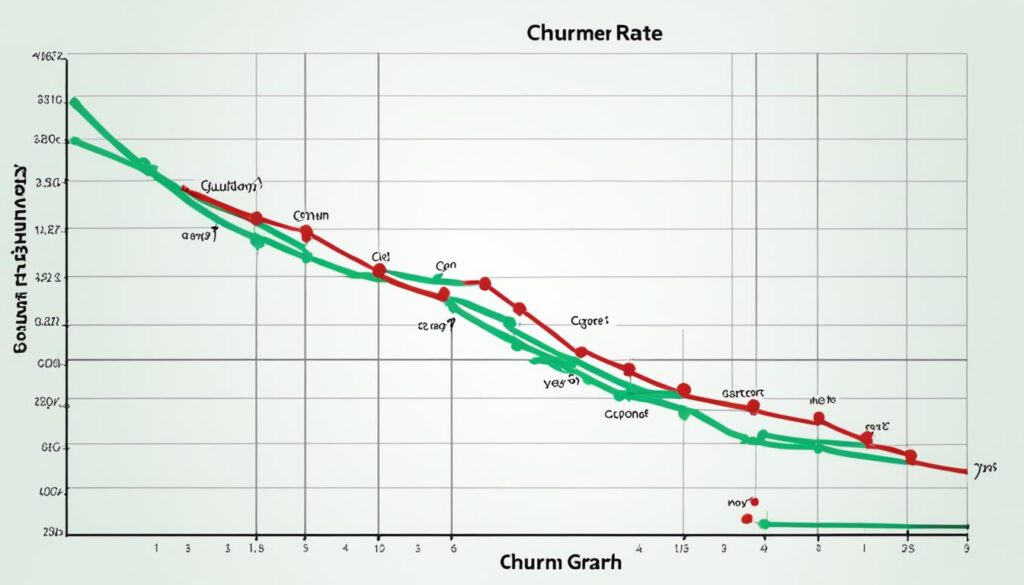Welcome to our article on customer churn rate, customer attrition rate, and customer turnover rate. Understanding these metrics is crucial for businesses looking to optimize customer retention and drive growth.
Customer churn rate refers to the percentage of customers that a company loses over a specific time period. It is a critical metric for measuring company performance and evaluating customer loyalty. By analyzing customer churn, businesses can gain valuable insights into their customer base, project future growth, calculate customer lifetime value, analyze retention efforts, and identify successful prospects.
In this article, we will delve into the concept of customer churn, discuss why it is critical for businesses, explore how to calculate churn rate accurately, examine strategic approaches to reducing churn, and highlight best practices for optimizing customer retention. We will also discuss how businesses can employ analytics to reduce customer churn and emphasize the importance of continuous monitoring and data-driven decision-making.
Whether you are a startup or an established company, this article will provide you with valuable insights and practical strategies to improve your customer retention and drive long-term success. Let’s dive into the world of customer churn rate and learn how to understand it better!
What Is Customer Churn and Why Is It Critical?
Customer churn refers to the act of a customer terminating their relationship with a company, typically by canceling a subscription or discontinuing a membership. Churn rate measures the percentage of customers who churn and is a critical metric for evaluating company performance. It is particularly important for businesses with a recurring revenue model.
Understanding customer churn rate is crucial for making projections, calculating customer lifetime value, analyzing retention efforts, and identifying successful prospects. By monitoring and managing churn rate, businesses can identify areas of improvement, implement strategies to retain customers, and drive overall company growth.
To illustrate the significance of customer churn rate, let’s consider a hypothetical example:
In a subscription-based software company, a high churn rate indicates that there may be issues with product satisfaction, customer support, or competitors offering better alternatives.
| Company A | Company B |
|---|---|
| Churn Rate: 15% | Churn Rate: 5% |
| Company performance: Below average | Company performance: Above average |
The above table highlights the impact of churn rate on company performance. Company A with a higher churn rate of 15% is underperforming compared to Company B, which has a churn rate of only 5%. This indicates that Company B is better at retaining customers and maintaining their subscriptions, leading to stronger overall company performance.

Understanding and monitoring customer churn rate is vital for businesses seeking to thrive in competitive markets. By addressing the factors that lead to customer churn and implementing effective retention strategies, companies can improve their customer relationships, enhance company performance, and drive long-term success.
How Do I Calculate Customer Churn?
Calculating customer churn can be complex and requires tracking three types of customers within a specific time period: renewals, new sign-ons, and those who leave. New customers often have higher churn rates compared to older ones, and a company’s growth rate can skew the results. Defining churn precisely is crucial, as it can occur when a subscription ends, when users cancel but are still technically customers, or even when involuntary events like failed auto-renewals happen. Accurate calculation of churn enables businesses to measure customer losses and make informed decisions about retention strategies.
When calculating churn rate, businesses need to consider the number of customers who renewed their subscriptions or memberships, those who signed up for new services, and those who discontinued their relationship with the company. By analyzing these three categories, businesses can determine the net changes in their customer base and calculate the churn rate accordingly.
Calculating Churn Rate Formula:
The formula for calculating customer churn rate is as follows:
Churn Rate (%) = (Number of Customers Lost / Total Starting Customers) x 100
For example, let’s consider a company that had 1,000 customers at the beginning of a given month. Throughout the month, they lost 100 customers. To calculate the churn rate:
Churn Rate (%) = (100 / 1,000) x 100 = 10%
Understanding the customer churn rate helps businesses identify trends, assess the effectiveness of their customer retention efforts, and focus on strategies to reduce churn. By calculating churn accurately, businesses can make data-driven decisions and implement targeted retention strategies to minimize customer losses and promote sustainable growth.

What Are Some Strategic Approaches to Reducing Churn?
Reducing churn requires a proactive approach. To effectively tackle customer attrition and retain valuable customers, businesses need to identify the different stages of churn and develop strategies for each stage. By implementing proactive strategies, businesses can reduce churn and increase customer loyalty, ultimately improving their bottom line.
Identifying the Stages of Churn
Customer churn can occur at various stages of the customer journey. It is important to understand these stages in order to implement targeted strategies for reducing churn.
- Churn that occurs right after customers try the product: Some customers may churn immediately after trying a product or service. This could be due to a lack of initial engagement or dissatisfaction with the product’s features or usability.
- Longer-term churn over time: Customers may churn over a longer period of time as they face challenges with the product, experience a decline in satisfaction, or find alternatives in the market.
- Dropoff of usage when other tools or competitors enter the picture: The entry of new tools or competitors in the market can result in customers switching to alternative solutions, leading to churn.
Focusing on Product-Market Fit
One of the key strategies to reduce churn is to ensure product-market fit. Businesses should continuously evolve their products to meet the changing needs of customers and address pain points throughout the customer journey.
“To reduce churn, it is important to actively listen to your customers, continuously learn from their feedback, and adapt your product to their evolving needs. By addressing pain points and providing solutions, you can enhance the product-market fit, improve customer satisfaction, and reduce churn.”
Strategies to Reduce Churn
| Strategy | Description |
|---|---|
| 1. Improve onboarding experience | Create a seamless onboarding process to ensure new customers have a positive first experience with your product or service. |
| 2. Provide exceptional customer support | Offer timely and helpful support to address customer issues and concerns, reducing the likelihood of churn. |
| 3. Implement customer success programs | Proactively engage with customers, ensuring they are successfully using your product and achieving their desired outcomes. |
| 4. Offer personalized recommendations | Utilize customer data to provide tailored recommendations and suggestions that enhance their experience with your product. |
| 5. Develop loyalty programs | Incentivize customer loyalty through rewards, exclusive offers, and special discounts to encourage ongoing engagement. |
Implementing these strategies will help businesses reduce churn, improve customer retention, and maintain a strong product-market fit, leading to long-term success.

What Are Some Best Practices for Reducing Churn?
Reducing churn is a crucial objective for businesses looking to improve customer retention and minimize revenue loss. By implementing best practices and leveraging key strategies, companies can enhance their ability to retain customers and increase their long-term loyalty. Here are some effective approaches to reducing churn:
Track User Behavior Through Analytics
Analytics is a powerful tool that can provide valuable insights into customer behavior. By tracking user interactions, businesses can identify patterns and trends that may indicate potential churn. Utilize analytics platforms to monitor key metrics such as user engagement, product usage, and customer satisfaction. These analytics can help identify areas of improvement and optimize retention efforts.
Use Behavioral Data to Identify Leading Indicators of Churn
Behavioral data offers valuable information about how customers interact with a product or service. By analyzing this data, businesses can identify specific behaviors that often precede churn. For example, a decrease in usage frequency or a decline in engagement may signify a potential churn risk. By understanding these indicators, businesses can take proactive steps to prevent churn before it happens.
Leverage Cohort Analysis to Analyze Customer Value and Behavior
Cohort analysis involves grouping customers based on similar characteristics or behaviors and analyzing their behavior over time. This analysis provides valuable insights into customer segments and helps identify trends or patterns that may affect churn. By understanding the unique needs and behaviors of different customer cohorts, businesses can develop tailored strategies to reduce churn and increase customer retention.
Ensure All Teams Have Access to the Same Customer Data for Targeted Efforts
Effective churn reduction strategies require collaboration across teams. It is crucial to ensure that all teams, including marketing, sales, and customer support, have access to the same customer data. This shared information enables targeted efforts to address customers’ needs and concerns, increasing the likelihood of retaining them. By aligning efforts and knowledge, teams can work together to create a seamless customer experience.
Make the Product “Sticky” by Encouraging Users to Adopt More Features
Creating a “sticky” product involves encouraging customers to adopt more features or services within the product ecosystem. By consistently adding value and introducing new features, businesses can increase customers’ reliance on the product, making it harder for them to switch to a competitor. Regularly communicate updates and educate customers on the benefits of additional features to foster a deeper level of engagement and reduce the likelihood of churn.
Provide Educational Materials and Incentives to Customers
Education plays a vital role in reducing churn. By providing customers with educational materials, such as tutorials, guides, and knowledge bases, businesses can empower them to get the most out of their purchase. Incentives, such as exclusive discounts or rewards, can also encourage customers to remain loyal and engaged. By continuously providing value and support, businesses can build stronger relationships with customers and improve retention rates.
Stay Relevant Through Ongoing Value
Staying relevant is essential to minimize churn. Continuously assess customers’ evolving needs and refine your product or service offerings accordingly. Regularly communicate with your customers and seek feedback to understand their changing requirements. By consistently delivering ongoing value that aligns with their needs, you can foster long-term relationships and reduce the likelihood of churn.
Analyze Customer Behavior Through Support Tickets
Support tickets offer valuable insights into customer behavior, pain points, and areas for improvement. Analyze support ticket data to identify common issues, concerns, or frustrations that may lead to churn. By addressing these challenges and providing effective solutions, businesses can enhance the overall customer experience and increase customer satisfaction, ultimately reducing churn.
Incorporate these best practices into your churn reduction strategy to optimize your activation, engagement, and retention efforts. By utilizing analytics, leveraging behavioral data, conducting cohort analysis, ensuring cohesive data sharing across teams, making the product “sticky,” providing educational materials and incentives, staying relevant, and analyzing customer behavior through support tickets, you can significantly improve customer retention and reduce churn, ultimately driving long-term success for your business.
How Can My Teams Employ Analytics to Reduce Customer Churn?
Analytics play a crucial role in reducing customer churn. By tracking user behavior and analyzing data, your business can optimize activation and engagement efforts, thereby increasing customer retention.
Utilizing behavioral data is key to understanding how customers find value in your product or service and identifying potential churn indicators. Cohort analysis allows you to group users based on demographics or behavior, enabling you to analyze customer value, loyalty, and retention.
One effective way to employ analytics is through product analytics. By leveraging data about how customers interact with your product, you can gain valuable insights into usage patterns, identify potential pain points, and make data-driven decisions to improve the customer experience.
Sharing customer data among teams is also crucial in optimizing retention efforts. When different teams have access to the same customer data, they can collaborate more effectively, align their strategies, and personalize their approach to enhance customer understanding and loyalty.
Here is a summary of how your teams can utilize analytics to reduce customer churn:
- Track user behavior and analyze data to optimize activation and engagement efforts.
- Utilize behavioral data to identify value and potential churn indicators.
- Apply cohort analysis to analyze customer value, loyalty, and retention.
- Leverage product analytics to gain insights, improve the customer experience, and make data-driven decisions.
- Share customer data among teams to enhance collaboration and personalize retention strategies.
| Advantages of Utilizing Analytics to Reduce Churn | How Analytics Helps |
|---|---|
| Optimize activation and engagement efforts | By tracking user behavior and analyzing data |
| Identify potential churn indicators | Through the use of behavioral data |
| Analyze customer value, loyalty, and retention | By applying cohort analysis |
| Improve the customer experience | By leveraging product analytics |
| Enhance collaboration and personalized strategies | By sharing customer data among teams |
Your teams can employ analytics to gain valuable insights and take proactive measures to reduce churn, ultimately increasing customer retention and driving business growth.
Conclusion
To succeed in today’s competitive business landscape, it is crucial to understand and manage your customer churn rate. By accurately calculating your churn rate, you can assess your company’s performance and forecast future growth. Implementing proactive strategies to reduce churn, utilizing analytics to optimize retention efforts, and focusing on increasing customer loyalty are key to enhancing customer retention and driving long-term success.
By continuously monitoring your churn rate and making data-driven decisions, you can improve customer retention and minimize revenue loss. Remember, every lost customer represents a missed opportunity. By prioritizing customer retention, you can build a thriving customer base that serves as the foundation for sustainable growth.
Reducing churn requires a comprehensive approach that involves understanding customer behavior, addressing pain points, and constantly evolving to meet changing needs. Additionally, utilizing analytics and leveraging customer data can provide valuable insights for optimizing activation, engagement, and retention efforts.
Ultimately, by focusing on reducing churn and increasing customer loyalty, you can create a strong bond with your customers, increase their lifetime value, and position your business for long-term success in the ever-changing marketplace.
FAQ
What is customer churn?
Customer churn refers to the act of a customer terminating their relationship with a company, typically by canceling a subscription or discontinuing a membership.
Why is customer churn critical?
Customer churn is a critical metric for evaluating company performance, measuring service cancellation, and analyzing customer attrition.
How do I calculate customer churn?
Calculating customer churn involves tracking renewals, new sign-ons, and those who leave within a specific time period.
What are some strategic approaches to reducing churn?
To reduce churn, businesses should focus on maintaining product-market fit and addressing pain points throughout the customer journey.
What are some best practices for reducing churn?
Best practices for reducing churn include tracking user behavior through analytics, leveraging cohort analysis, and providing educational materials to customers.
How can my teams employ analytics to reduce customer churn?
By utilizing analytics and sharing customer data among teams, businesses can optimize retention efforts and increase customer loyalty.
How can I increase customer loyalty and reduce churn?
Monitoring customer churn rate, implementing proactive strategies, and making data-driven decisions can improve customer retention and minimize revenue loss.
